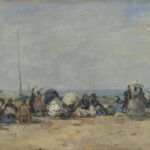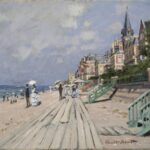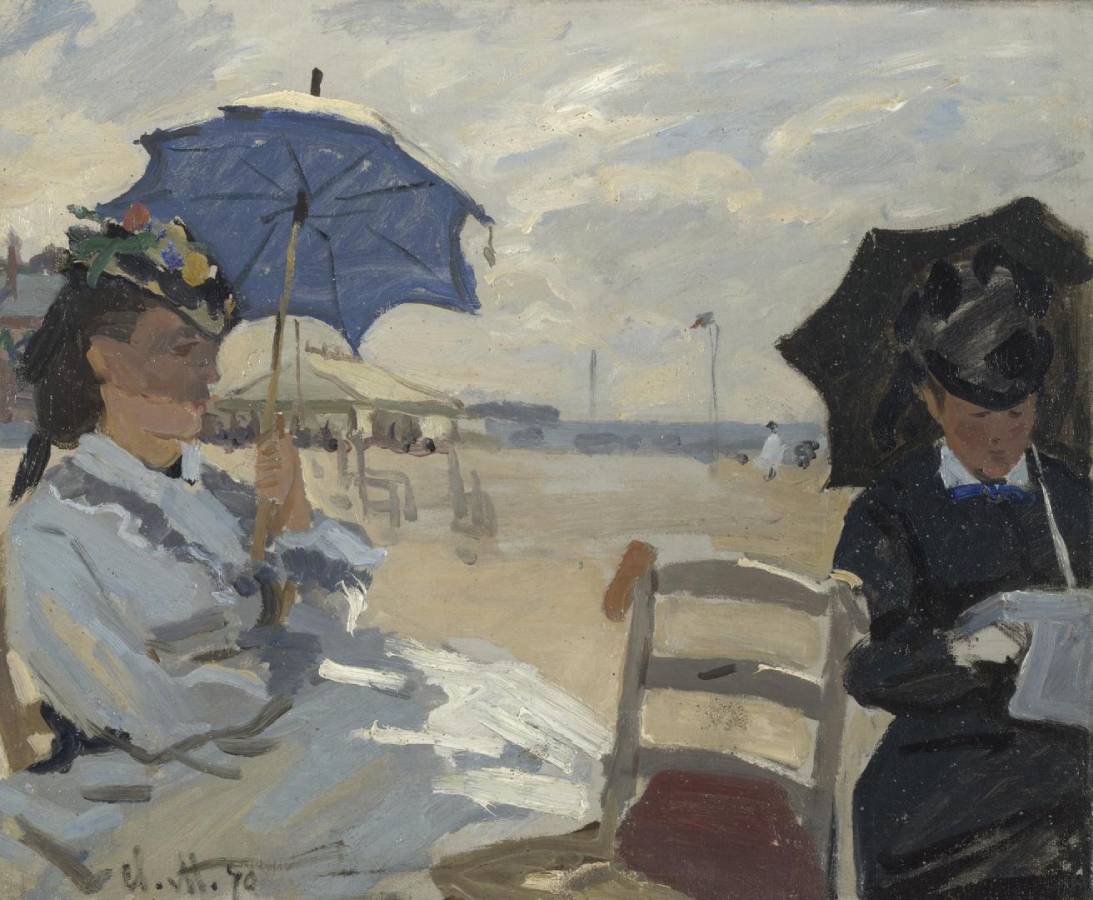Monet, Claude (1840-1926)
La plage de Trouville (The Beach at Trouville)
1870
Oil on canvas, 38 × 46.5 cm
National Gallery, London
Monet’s earlier paintings of the Normandy coast had emphasised it as a working seascape, peopled with fishermen who had to contend with a cold climate, choppy seas and stormy skies. But this painting and the eight others he made in the summer of 1870 show it as a holiday destination, with wide sandy beaches, bracing air and impressive seaside architecture. Monet painted it during the weeks he spent at Trouville with his wife Camille and their son Jean.
Camille and a female companion are shown in close-up, their figures apparently casually arranged and cropped by the picture frame, rather like a snapshot. Grains of sand embedded in the paint reveal that the canvas was painted at least partly on the spot. Facial features and costume details are dashed in briefly with flat strokes of paint: the main focus here is on the play of light and shade. Bright sunlight is conveyed in bold strokes of brilliant white, and the women shade their faces with parasols.
Monet’s earlier paintings of the Normandy coast, such as La Pointe de la Hève, Sainte-Adresse, had emphasised it as a working seascape, peopled with fishermen who had to contend with a cold climate, choppy seas and stormy skies. But this painting and the eight others he made in the summer of 1870 show it as a holiday destination, with wide sandy beaches, bracing air and impressive seaside architecture.
Monet painted it during the weeks he spent at Trouville following his marriage, with his new wife Camille and their son Jean. Monet’s fellow painter and friend Eugène Boudin was also spending the summer at Trouville, and the two men sometimes painted side-by-side in the open air. During his stay Monet produced four large canvases – one view of the harbour and three paintings of the seafront lined with smart hotels – as well as five smaller pictures of figures on the beach, of which this is one. The smaller pictures may have been made as studies for larger paintings that were never realised, but the fact that this one is signed with Monet’s initials might indicate that he saw it as complete in itself.
Camille posed for most of the beach scenes. Here she is shown relaxing with a woman who has been variously identified as Madame Boudin, Camille’s sister or a member of Monet’s family. The composition is daring and innovative; where Boudin’s Trouville scenes (such as Beach Scene, Trouville) depict lines of fashionably dressed figures on the beach seen from a distance, Monet shows the two women in close-up, their figures apparently casually arranged and cropped by the picture frame, rather like a snapshot.
Grains of sand blown by the sea breeze onto the canvas that became embedded in the wet paint reveal that it was painted at least partly on the spot. Colours are mainly limited to tones of yellow, grey, blue and black. Facial features and costume details are dashed in briefly with flat strokes of paint: the main focus here is on the play of light and shade. The bright sunlight is conveyed in bold strokes of brilliant white, and the women shade their faces with parasols. It is possible that Camille is wearing a veil to protect her skin. In her pale summer dress and flowery hat, she seems lost in thought, while her companion, dressed in contrasting black, seems intent on reading her newspaper. A child’s shoe hooked on the back of the chair may belong to the three-year-old Jean. Distant figures, a tent and other features are sketched in with a few strokes of the brush. The flag on the flagpole and the scudding clouds tell us that despite the dazzling sunlight this is a breezy day.
The picture may appear to sum up the carefree atmosphere of a summer holiday, but life for the Monet family was far from carefree at the time. France had just declared war on Prussia, and the future must have looked very uncertain. At the end of the summer season Monet sailed for England to escape the fighting in Paris, but only after a delay because he had been unable to pay the bill for his Trouville hotel. (NG)
Compare:
 Boudin, Eugène (1824-1898)
Boudin, Eugène (1824-1898)
Scène de plage à Trouville
c.1860–1870
National Gallery, London
 Monet, Claude (1840-1926)
Monet, Claude (1840-1926)
La plage de Trouville
1870
Wadsworth Atheneum, Hartford
See also:
• Doncieux, Camille (1847-1879) | Trouville-sur-Mer (France)
